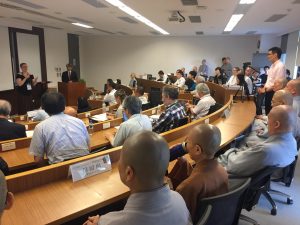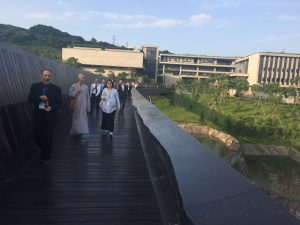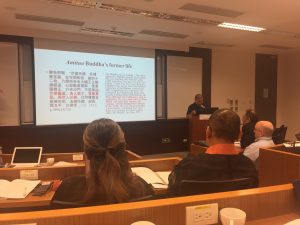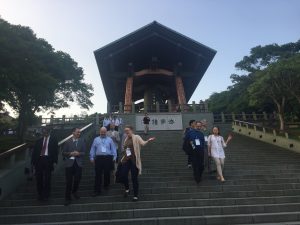
The hot topic was meditation and Pure Land Buddhism, rarely discussed in Jodo Shinshu circles. But that was the theme of the International Association of Shin Buddhist Studies 19th Biennial Meeting in Taiwan last month.
Scholars, students, Buddhist priests, laypeople and other interested participants from Japan, Canada, Taiwan, Poland, and the United States, joined the lectures and discussions held May 24 through May 26 at Dharma Drum Institute of Liberal Arts in New Taipei City.
The meeting’s topic was particularly intriguing because Jodo Shinshu teachings generally dismiss meditation practices as provisional based on self-power effort, ultimately proving futile. Instead, the teachings emphasize “other power” or “power beyond self,” expressed traditionally as reliance on Amida Buddha’s great compassion.

Professors and researchers from various universities presented their ideas. For example, Yuichi Tsunoda of Sophia University in Tokyo discussed how the influential Shinshu thinker Manshi Kiyozawa engaged in various types of contemplation, considering “existential” problems, including the function of “will,” birth, death, emptiness and absolute infinite reality. He also practiced “moral” contemplation.
Toshikazu Arai, professor emeritus of Soai University in Osaka, proposed in his paper that nenbutsu, reciting Amida Buddha’s name, is the “ultimate form of meditation that assures us to meet the Buddha and attain birth in the Buddha’s world.” Two presenters discussed meditation from a Jodo Shu Buddhism perspective. Tatsuji Hojo, a researcher from Jodo Shu Research Institute in Tokyo, talked about “Buddhist Meditative Elements in the Teaching of Honen.” Tatsuaki Harumoto from the same institute, presented a paper titled “Meditation and Honen’s Pure Land Buddhism.”

Representing Chan Buddhism, Ven. Guojing, dean at Chung-hua Institute of Buddhist Studies in New Taipei City, presented a paper titled, “Non-duality of Chanting Buddha’s Name and Can-chan: Contemporary Challenge and Development.” Yawen Chang, a Ph.D. student at Dharma Drum Institute, discussed “Instructional Action research on Practice of Meditation in Daily Life: Using the Method of Chanting Buddha’s Name by Counting Beans.” Kamil Nowak, a visiting Ph.D. candidate from Jagiellonian University in Poland, discussed “Chan, Pure Land Buddhism, and Some Reflections on the Process of Decontextualisation of Religious Experience.”
Other topics discussed included “Shin Buddhist Thought in the Early Modern Period,” “Overseas Activities of Shin Buddhism,” and “Life Story of Shinran.” Dr. Kenneth Tanaka, professor emeritus of Musashino University in Tokyo, gave a keynote lecture entitled “The Role of the Visualization Sutra in the Formation of Pure Land Practice in China: Visualization and Recitation.”
Session chairs included Institute of Buddhist Studies dean Scott Mitchell, Dharma Drum Institute professor Ven. Guoxing, and Otani University professor Michael Conway.

Looking ahead at the future of Shin Buddhist studies, panelists encouraged collaboration between scholars across a broader spectrum of countries, languages, and religious traditions. For example, scholars from Korean and China, absent from the weekend’s proceedings, could inject Shinshu studies with new points of view and a fresh perspective. Panelists and participants included Ryukoku University professor Mitsuya Dake, UC Berkeley professor Mark Blum, University of British Columbia professor Jessica Main, Otani University professor Takami Inoue, and Dharma Drum Institute professor Wejen Teng.
The following is a list of the papers and topics:
-“Dynamics of Contemplation: The Structure of Self-Recognition in Kiyozawa Manshi,” Yuichi Tsunoda, Associate Professor, Sophia University, Tokyo, Japan
-“The Creation of the Authority of Tannisho in the Modern Period,” Nobuya Dake, Ph.D. candidate, Ryukoku University, Kyoto, Japan
“Two Paradigms of Shin Studies: A Kuhnian Analysis,” Jeff Schroeder, assistant professor, University of Oregon, Eugene, Oregon
-“On the Practical System in the Pure Land Sutras,” Yue Xiao, researcher, Bukkyo University, Kyoto, Japan
-“Unofficial Envoy: Shin Ministers Who Went to Hawaii Prior to Hongwanji’s mission,” Ichido Kikukawa, Ryukoku University, Kyoto, Japan
-“Jodo Shinshu in California: Observations, Trends and Challenges,” Ken Yamada, editor, Shinshu Center of America, Berkeley, California
-“Shinran’s Training at Enryaku-ji Temple on Mt. Hiei as ‘Doso,’” Junsho Hashimoto, research assistant, Hongwanji Research Institute
-“An Examination of Shin Propagation in Terms of Legendary Stories Told About Shinran,” Ryoei Nanjo, adjunct lecturer, Musashino University, Tokyo, Japan
-“The Process of Constructing the Couple Image of ‘Shinran-Eshinni’ in the Japanese Modern Period,” Ayako Osawa, postdoctoral fellow, The Shin Buddhist Comprehensive Research Institute, Tokyo, Japan
-“Non-duality of Chanting Buddha’s Name and Can-chan: Contemporary Challenge and Development,” Ven. Guojing, associate professor, Dharma Drum Institute, dean, Chung-hua Institute of Buddhist Studies, New Taipei City, Taiwan
-“Instructional Action Research on Practice of Meditation in Daily Life: Using the Method of Chanting Buddha’s Name by Counting Beans,” Yawen Chang, Ph.D. student, Dharma Drum Institute, New Taipei City, Taiwan
-“Chan, Pure Land Buddhism, and Some Reflections on the Process of Decontextualisation of Religious Experience,” Kamil Nowak, Ph.D. candidate, Jagiellonian University, Poland, visiting student, Dharma Drum Institute, New Taipei City, Taiwan
-“Nembutsu as the Ultimate Form of Meditation,” Toshikazu Arai, Professor Emeritus, Soai University, Osaka, Japan
-“Buddhist Meditative Elements in the Teaching of Honen,” Tatsuji Hojo, researcher, Jodo Shu Research Institute, Tokyo, Japan
-“Shinran’s Criticism of the ‘Transfer of Merit’ as Self-Powered Practice,” Takami Inoue, professor, Otani University, Kyoto, Japan
-“Meditation and Honen’s Pure Land Buddhism,” Tatsuaki Harumoto, researcher, Jodo Shu Research Institute, Tokyo, Japan
-“Relationship between Pratyutpanna Samadhi and Suramgama Samadhi,” Zuiyo Sawazaki, Ph.D. candidate, Otani University, Kyoto, Japan
-“Genshin’s Development of a Method for Contemplating Amida’s Byakugo and its Influence on Japanese Pure Land Practice,” Eisho Nasu, professor, Ryukoku University, Kyoto, Japan
-“Asceticism or Meditation? Some Remarks on the True Character of Practices Preceding the Buddha’s Awakening in Early Buddhist Texts,” Grzegorz Polak, professor, Maria Curie Sklodowska University, visiting professor, Chengchi University/Dharma Drum Institute, New Taipei City, Taiwan
Some of the papers from the meeting may be accessed here.
-Rev. Ken Yamada, editor, Shinshu Center of America

